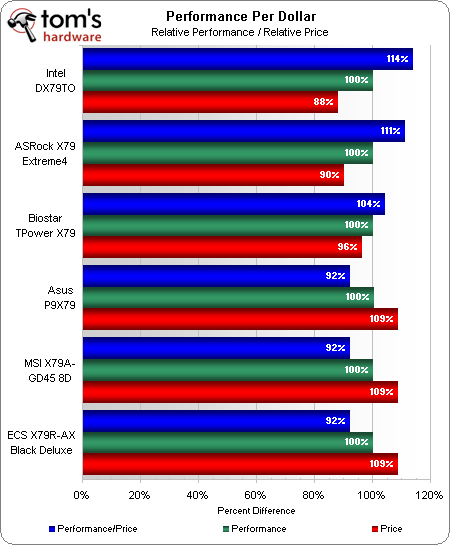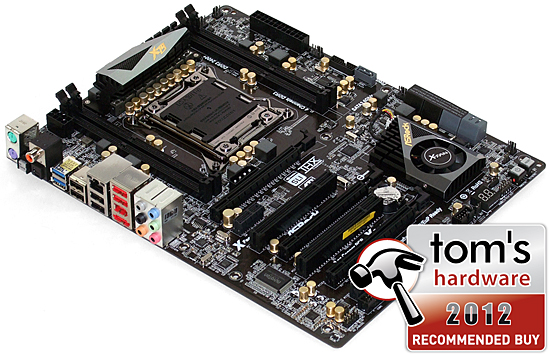Six $200-$260 LGA 2011 Motherboards, Reviewed
We know that Intel's X79 Express platform hosts the fastest desktop processors in the company's portfolio. But can it be made more affordable? We round up the least-expensive $200-$260 motherboards to determine how much you have to give up for cheap X79.
Which X79-Based Motherboard Offers More Value?
Today’s motherboards range from Intel’s $210 DX79TO to a $260 price shared by Asus, MSI, and ECS. Gigabyte’s X79A-UD3 might have also fit within our qualifying range, had its board not already been used for our $260 to $320 roundup. If you want to know more about the Gigabyte platform, check out Seven $260-$320 X79 Express Motherboards, Reviewed.
Because all of today’s boards exhibit similar performance, a price-per-performance chart primarily reflects price.
For $5 more than Intel's baseline, ASRock’s X79 Extreme4 adds three-way SLI, front-panel USB 3.0, rear-panel digital ports, twice as many analog audio jacks, three more SATA ports, and eSATA. While all of those features are worth several times as much as the price difference, we're left wondering how much money ASRock saved by leaving out the second set of DIMM slots.
Biostar’s TPower X79 goes a step further by integrating four more USB 3.0 ports compared to the X79 Extreme4. It still has only a single set of memory slots, however, and we’re unhappy to find its front-panel USB 3.0 header located less than one space below its third graphics slot. While most builders at this budget level don’t plan to use three graphics cards, we like to leave that option available when the slots are there. Furthermore, the TPower X79 is an extraordinarily troublesome overclocker. All of these things diminish the value of its added peripheral connectivity, compelling us to choose between ASRock and Intel.
Asus’ P9X79 splits the difference between the two most value-oriented boards by offering four rear-panel USB 3.0 ports but—strangely—no front-panel USB 3.0 headers. The board also comes up two SATA ports shy of the X79 Extreme4, and its super-valuable USB BIOS Flashback feature is so infrequently needed that it alone can’t justify its significantly-higher $260 price.
Nobody needs a win right now more than MSI, and the firm does beat its competitors with impressive efficiency. Like the TPower X79, MSI’s X79A-GD45 also has the problem of an unfortunately-placed front-panel USB 3.0 header. Anyone who knows for certain that they’ll never place a conflicting card in the bottom PCI Express slot should consider its superb efficiency as a reason to buy, though we find it hard to justify a $45 mark-up (compared to the similarly-featured X79 Extreme4) for its second set of memory slots.
ECS’ X79R-AX Deluxe faces several challenges compared to the competition, beginning with the fact that it was the only board to require a firmware update simply to support our new CPU. Anyone who orders a new processor with this board could potentially suffer the same fate. This is one of those instances where a feature similar to Asus’ USB BIOS Flashback could truly be useful, but ECS doesn’t have it. That could explain why the X79R-AX Deluxe is out-of-stock everywhere we looked.
Get Tom's Hardware's best news and in-depth reviews, straight to your inbox.
This leads us back to a race between ASRock’s X79 Extreme4’s added features and the extra memory slots provided by Intel’s DX79TO. We could try to use the DX79TO’s higher efficiency to offset its lack of front-panel USB 3.0 support, but we prefer to have both. We were also disappointed that Intel chose to use only 32 of the CPU's 40 PCIe lanes by leaving off the third graphics slot. Add superior CPU overclocking to its superior feature set, and ASRock’s X79 Extreme4 takes the value crown.
Current page: Which X79-Based Motherboard Offers More Value?
Prev Page Overclocking-
I like Asrock boards. I have an 880GM-LE mATX and a Z68 Pro3 Gen3 ATX and both are good performance and price-performance wise.Reply
-
hellfire24 Asrock is dominating both high end and mid range market.extreme3/gen3 1155 is awesome and cheapest pci-e 3.0 sli capable mobo.Asrock FTW!!!Reply -
Achoo22 ReplyQuite simply, the costs associated with Sandy Bridge-E are higher, in part because of Intel's prices and also because the boards are more difficult to design.
Since the boards all have vastly superior profit margins, your statement is misleading. Why is everyone too afraid to reveal the truth about motherboard pricing? -
AlexIsAlex Would it be possible, in future motherboard reviews, to include a measure of the cold boot (POST) time? This is something that different bioses can be differentiated on, and UFEI offers the potential for very fast boots if manufacturers take advantage of it properly.Reply
A comparison of the time between the power button being pressed and the installed bootloader starting would be very interesting to me. I was thinking it might be easiest to measure this by having no OS on the boot media and measuring the time to the "please insert boot media" message, but I'm sure you can think of other ways of doing it.
I'm also informed that on some boards the boot time varies dramatically dependent on whether any Overclocking is enabled, as compared to the stock settings - that would also be worth knowing. -
americanbrian your feature table says the asrock extreme 4 comes with an 8 phase voltage regulator, but the text of article says 10 phase...which is it ?Reply -
KT_WASP crisan_tiberiuASRock = ASUSReply
not anymore, asrock is no longer affiliated with Asus and is owned by Pegatron Corp. -
memadmax I wish tom's would do a "best motherboards for the money" or something close to that.Reply


